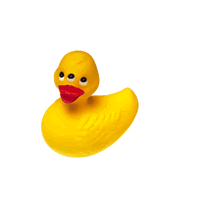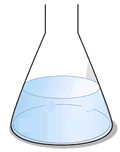|
The technique of back titration is used when the unknown compound cannot be dissolved in water for normal titration. The compound can however react with an acid, neutralising some of it. The remaining acid may then be titrated in the usual manner. |
|
Back Reactions
The basic concept is used in many walks of life. If you go into a shop with 8.00 €uros to buy, for example, a rubber duck, you can find out the cost of the article by looking at the change the shop assistant gives back.
 |
 |
 |
| You walk into the shop with coins worth ... | And you walk out of the shop with coins worth... | The rubber duck must have cost the difference between the coins. |
|
8.00 €uros
|
4.30 €uros
|
8 - 4.30 = 3.70 €uros
|
Total money = 8.00 €uros
Change received = 4.30 €uros
Cost of item = 8.00 - 4.30 = 3.70 €uros
In the case of chemistry this would be:
Total acid = 2.0 moles
Acid remaining = 1.6 moles
Acid used up in initial reaction = 2.0 - 1.6 = 0.4 moles
The experimental procedure, then, must focus on finding out the amount of acid remaining after the initial reaction. All of the other factors can be calculated from the amount of acid remaining and the other directly recorded data (mass of solid, initial molarity and volume of the acid before reaction).
NOTE Although all of the examples discussed here involve acids, back titration is not their exclusive domain - the principles involved here can also be applied to other reaction systems.
General procedure
- React a known mass of the solid to be analysed with an excess (but known) amount of acid.
- Make up the excess acid to a specific volume and titrate against a standard base.
- Calculate the amount of acid remaining (the excess).
- Calculate the amount of acid used up in the original reaction by subtraction from the initial number of moles.
- Calculate the number of moles present in the original solid by consideration of the stoichiometry of the reaction.
Uses of Back-titration
- Finding the relative formula mass of an unknown carbonate
- Identifying the metal in an unknown metal oxide
- Finding the purity of an known carbonate mixture
- Finding the percentage metal in an alloy
Finding the relative formula mass of an unknown carbonate
Procedure
- Weigh out about 2.5 g of the unknown carbonate
- Dissolve the unknown carbonate in 50 cm3 of 2M HCl (an excess of acid - it will react with all of the carbonate and there will be some acid left over)
- Make up the reaction mixture to 250 cm3 in a volumetric flask
- Titrate 25 cm3 aliquots against a standardised solution of sodium hydroxide (0.1M) using phenolphthalein indicator
Typical results
Mass of unknown carbonate = 2.64g
|
Titration
|
initial burette reading (± 0.05)
|
final burette reading (± 0.05)
|
vol NaOH/cm3 (± 0.1)
|
|
1
|
0.0
|
38.3
|
38.3
|
|
2
|
0.0
|
37.2
|
37.2
|
|
3
|
0.0
|
37.1
|
37.1
|
|
average concordant
|
37.15
|
Treatment of results
Volume of 0.1M sodium hydroxide used in titration = 37.15 cm3
Moles of sodium hydroxide = 0.1 x 0.03715 = 0.003715 moles
Moles of sodium hydroxide = moles of hydrochloric acid = 0.003715 moles
But only 25 cm3 samples taken from a 250cm3 volumetric flask were titrated, therefore the total moles of hydrochloric acid in the volumetric flask was 0.003715 moles x 250/25 = 0.03715 moles
Original moles of hydrochloric acid = molarity x volume = 2 x 0.05 = 0.1
Therefore, moles of hydrochloric acid neutralised in the original reaction with the unknown carbonate = 0.1 - 0.03715 = 0.06285 moles
Reaction of an acid with a carbonate is:
From the stoichiometry 2 moles of acid is required to react with 1 mole of carbonate
Moles of hydrochloric acid = 0.06285 moles therefore moles of carbonate = 0.06285/2 moles = 0031425
The mass of the unknown carbonate = 2.64g
Therefore the relative formula mass of the unknown carbonate = mass/moles = 2.64/0.031425 = 84.01
The carbonate group CO32- has a relative mass of 12 + 48 = 60
Therefore the metal in the unknown carbonate has a relative mass of 84 - 60 = 24
The unknown carbonate is magnesium carbonate
Identifying the metal in an unknown metal oxide
Procedure
- Weigh out about 2 g of the unknown oxide
- Dissolve the unknown oxide in 50 cm3 of 2M hydrochloric acid
- Make up the reaction mixture to 250 cm3 in a volumetric flask
- Titrate 25 cm3 aliquots against a standardised solution of sodium hydroxide (0.1M) using phenolphthalein indicator
Typical results
Mass of unknown oxide = 2.44 g
|
Titration
|
initial burette reading (± 0.05)
|
final burette reading (± 0.05)
|
vol NaOH/cm3 (± 0.1)
|
|
1
|
0.0
|
13.3
|
13.3
|
|
2
|
0.0
|
12.9
|
12.9
|
|
3
|
0.0
|
12.8
|
12.8
|
|
average concordant
|
12.85
|
Treatment of results
Volume of 0.1M sodium hydroxide used in titration = 12.85 cm3
Moles of sodium hydroxide = 0.1 x 0.01285 = 0.001285 moles
Moles of sodium hydroxide = moles of hydrochloric acid = 0.001285 moles
But only 25 cm3 samples taken from a 250 cm3 volumetric flask were titrated, therefore the total moles of hydrochloric acid in the volumetric flask was 0.001285 moles x 250/25 = 0.01285 moles
Original moles of hydrochloric acid = molarity x volume = 2 x 0.05 = 0.1
Therefore moles of hydrochloric acid neutralised in the original reaction with the unknown carbonate = 0.1 - 0.01285 = 0.08715 moles
Reaction of an acid with an oxide:
Therefore 2 moles of acid is required to react with 1 mole of oxide
Moles of hydrochloric acid = 0.08715 moles therefore moles of carbonate = 0.08715/2 moles = 0.043575 moles
The mass of the unknown carbonate = 2.44g
Therefore the relative formula mass of the unknown carbonate = mass/moles = 2.44/0.043575 = 55.995
The oxide ion O2- has a relative mass of 16
Therefore the metal in the unknown oxide has a relative mass of 56 -16 = 40 (calcium has a relative atomic mass of 40)
The unknown oxide is Calcium oxide
Finding the purity of an impure carbonate or oxide
An impure sample of magnesium oxide is provided. (The impurity does not react with acid) An example of this could be an investigation of the purity of an indigestion tablet. These usually contain a base, such as magnesium hydroxide, magnesium oxide or sodium hydrogen carbonate etc, mixed with an inert substance.
Procedure
- Weigh the sample of the impure magnesium oxide
- Dissolve the impure magnesium oxide in 50 cm3 of 2M HCl
- Make up the reaction mixture to 250 cm3 in a volumetric flask
- Titrate 25 cm3 aliquots against a standardised solution of sodium hydroxide (0.1M) using phenolphthalein indicator
Typical results
Mass of impure magnesium oxide = 3.75 g
|
Titration
|
initial burette reading (± 0.05)
|
final burette reading (± 0.05)
|
vol NaOH/cm3 (± 0.1)
|
|
1
|
0.0
|
20.2
|
20.2
|
|
2
|
0.0
|
18.6
|
18.6
|
|
3
|
0.0
|
18.6
|
18.6
|
|
average concordant
|
18.60
|
Treatment of results
Volume of 0.1M sodium hydroxide used in titration = 18.60cm3
Moles of sodium hydroxide = 0.1 x 0.0186 = 0.00186 moles
Moles of sodium hydroxide = moles of hydrochloric acid = 0.00186 moles
But only 25cm3 samples (aliquots) taken from a 250cm3 volumetric flask were titrated, therefore the total moles of hydrochloric acid in the volumetric flask was 0.00186 moles x 250/25 = 0.0186 moles
Original moles of hydrochloric acid = molarity x volume = 2 x 0.05 = 0.1
Therefore moles of hydrochloric acid neutralised in the original reaction with the unknown carbonate = 0.1 - 0.0186 = 0.0814 moles
Reaction of an acid with an oxide:
Therefore 2 moles of acid is required to react with 1 mole of magnesium oxide
Moles of hydrochloric acid = 0.0814 moles therefore moles of magnesium oxide = 0.0814/2 moles = 0.0407 moles
Magnesium oxide has the formula MgO - relative formula mass = 40
Therefore 0.0407 moles has a mass of 0.0407 x 40 = 1.628g
The mass of the impure magnesium oxide = 3.75g
Therefore percentage magnesium oxide in the impure sample = 1.628/3.75 x 100 = 43.4%
Finding the percentage metal in an alloy
A sample of an iron/copper alloy was weighed and reacted with excess sulfuric acid. The iron reacts with the sulfuric acid while the copper remains unreacted.
Procedure
- Weigh out about 4 g of the alloy mixture
- Add 50 cm3 of 1M sulfuric acid
- Make up the mixture to 250 cm3 in a volumetric flask
- Extract 25 cm3 aliquots and titrate against a standardised solution of sodium hydroxide (0.1M) using phenolphthalein indicator
Typical results
Mass of alloy = 3.6g
|
Titration
|
initial burette reading (± 0.05)
|
final burette reading (± 0.05)
|
vol NaOH/cm3 (± 0.1)
|
|
1
|
0.0
|
14.2
|
14.2
|
|
2
|
0.0
|
14.1
|
14.1
|
|
3
|
0.0
|
14.1
|
14.1
|
|
average concordant
|
14.10
|
Volume of sodium hydroxide = 14.10 cm3
Treatment of results
Moles of sodium hydroxide = 0.1 x 0.0141 = 0.00141 moles
2 moles NaOH is equivalent to 1 mole of sulfuric acid
Moles of acid used in the titration = 0.00141/2 = 7.05 x 10-4
But this was from a 25cm3 aliquot taken from a 250 cm3 flask
Therefore moles of sulfuric acid in volumetric flask = 10 x 7.05 x 10-4 = 7.05 x 10-3 moles
Initial moles of sulfuric acid = 0.05 x 1 = 0.05 moles
Therefore moles of sulfuric acid that reacted with the alloy = 0.05 - 7.05 x 10-3 = 0.04295 moles
sulfuric acid reacts with iron:
moles of acid = moles of iron
Therefore moles of iron reacted = 0.04295 moles
Relative atomic mass of iron = 56
Mass of iron in the alloy sample = 56 x 0.04295 = 2.405g
Total mass of alloy sample = 3.6g
Percentage of iron in the alloy = 2.405/3.6 x 100 = 66.8%


